中考英语二轮语法专项复习课件 第09讲 动词分类
文档属性
| 名称 | 中考英语二轮语法专项复习课件 第09讲 动词分类 | 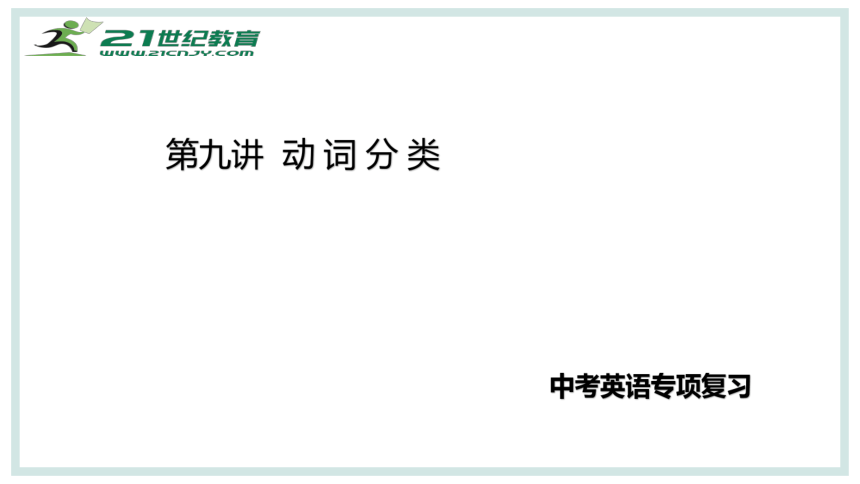 | |
| 格式 | pptx | ||
| 文件大小 | 1.4MB | ||
| 资源类型 | 试卷 | ||
| 版本资源 | 鲁教版 | ||
| 科目 | 英语 | ||
| 更新时间 | 2023-12-24 09:37:01 | ||
图片预览




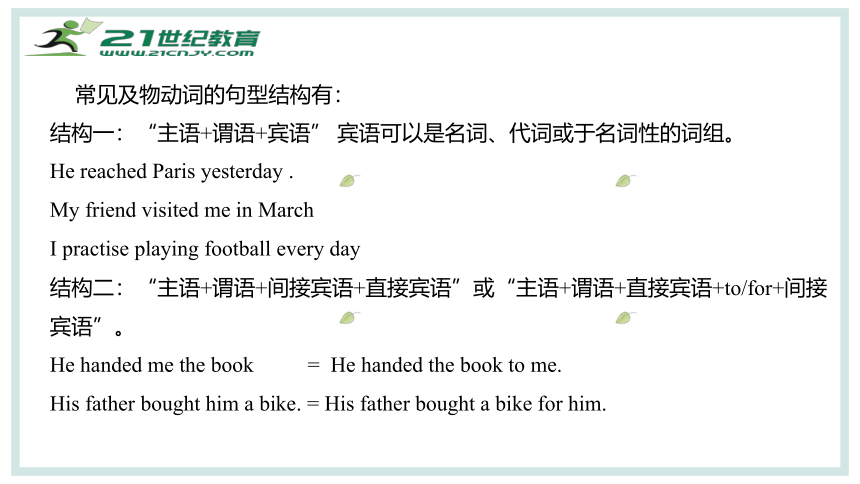

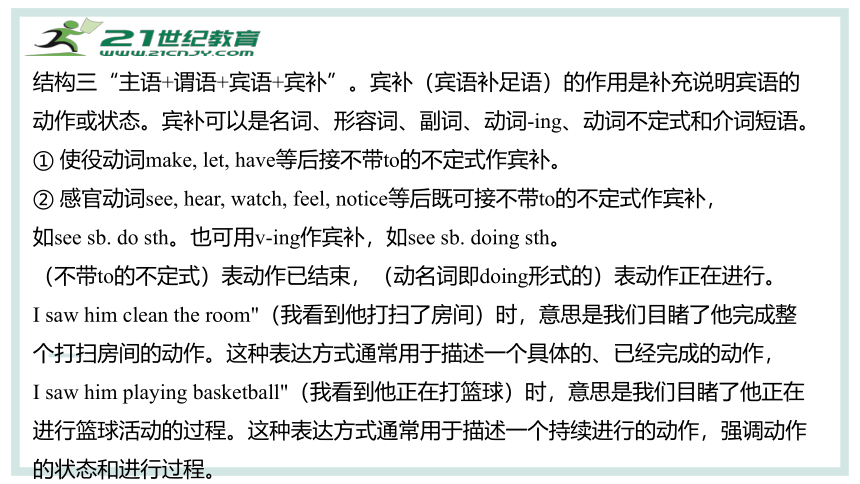
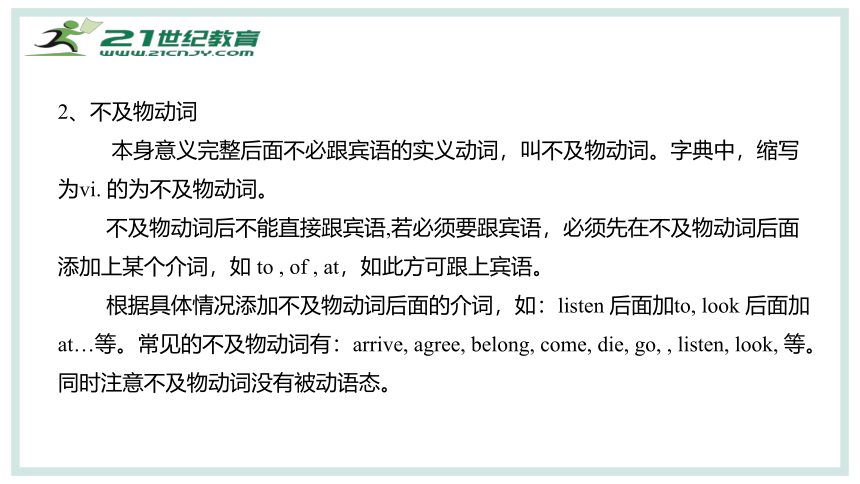
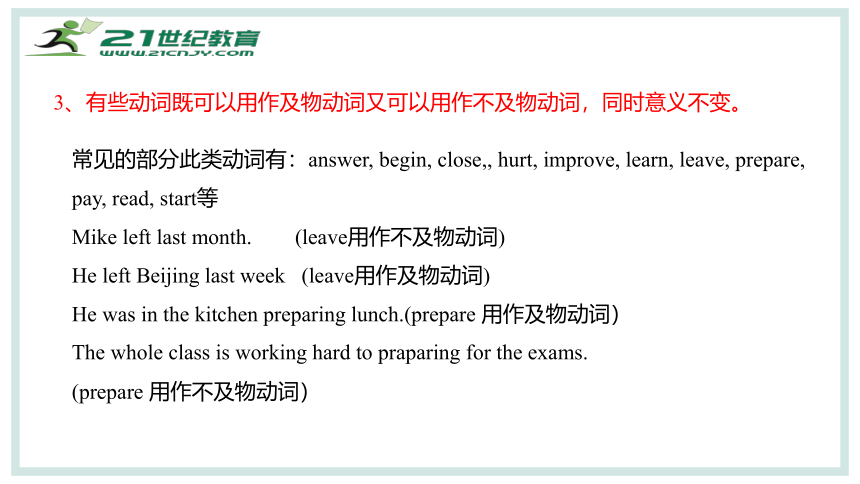
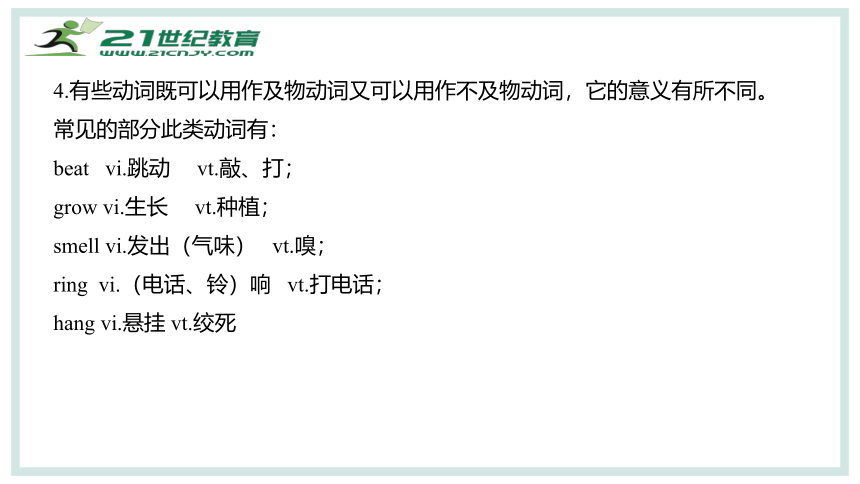
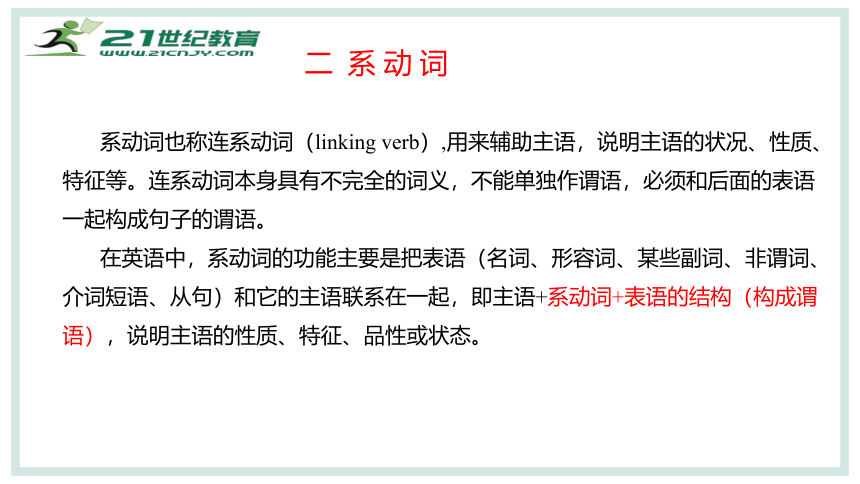
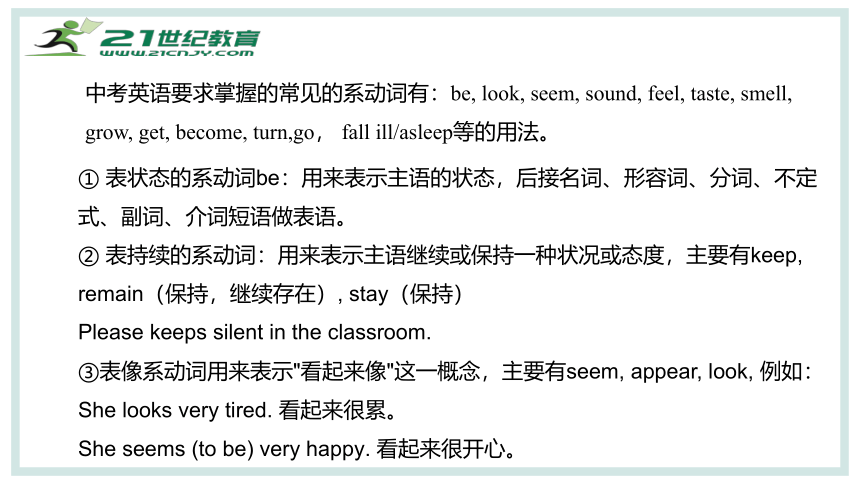
文档简介
(共53张PPT)
第九讲 动 词 分 类
中考英语专项复习
1.能够掌握动词的分类及每类动词的使用;
2.正确区分容易混淆的动词类型和词组,并灵活使用
学习目标
一 实 义 动 词
指的是具有实际意义的动词,它们表示具体的动作或状态。实义动词意思完全, 能独立用作谓语。
实义动词依据动词后面可否直接接宾语,可分为及物动词和不及物动词。
1. 及物动词
后面直接加宾语,加上后面的宾语意义才完整的实义动词。字典中,缩写为vt. 为及物动词。常见的及物动词有:see,watch,eat,drink,do,take,beat,buy,cut,carry,drive,give,hit,kick,lend,make,
open,read,study,try,use,wash, catch, invent, found, like, offer, prevent, promise, raise,等。
常见及物动词的句型结构有:
结构一:“主语+谓语+宾语” 宾语可以是名词、代词或于名词性的词组。
He reached Paris yesterday .
My friend visited me in March
I practise playing football every day
结构二:“主语+谓语+间接宾语+直接宾语”或“主语+谓语+直接宾语+to/for+间接宾语”。
He handed me the book = He handed the book to me.
His father bought him a bike. = His father bought a bike for him.
注意:在bring, give, hand, lend, pass, sell, send, show, take, return等动词后用to,表示“给”,强调动作的对象。
Have you sent a postcard to your mother yet
你给你母亲寄明信片了没有?
在buy, cook, choose, do, get, leave, make, sing, find等后面用for,表示“为了,替”, 强调动作的目的。
I chose a beautiful gift for my mother.
文本信息
标题数字等都可以通过点击和重新输入进行更改。文字数字大小颜色参考此模板
结构三“主语+谓语+宾语+宾补”。宾补(宾语补足语)的作用是补充说明宾语的动作或状态。宾补可以是名词、形容词、副词、动词-ing、动词不定式和介词短语。
① 使役动词make, let, have等后接不带to的不定式作宾补。
② 感官动词see, hear, watch, feel, notice等后既可接不带to的不定式作宾补,
如see sb. do sth。也可用v-ing作宾补,如see sb. doing sth。
(不带to的不定式)表动作已结束,(动名词即doing形式的)表动作正在进行。
I saw him clean the room"(我看到他打扫了房间)时,意思是我们目睹了他完成整个打扫房间的动作。这种表达方式通常用于描述一个具体的、已经完成的动作,
I saw him playing basketball"(我看到他正在打篮球)时,意思是我们目睹了他正在进行篮球活动的过程。这种表达方式通常用于描述一个持续进行的动作,强调动作的状态和进行过程。
2、不及物动词
本身意义完整后面不必跟宾语的实义动词,叫不及物动词。字典中,缩写为vi. 的为不及物动词。
不及物动词后不能直接跟宾语,若必须要跟宾语,必须先在不及物动词后面添加上某个介词,如 to , of , at,如此方可跟上宾语。
根据具体情况添加不及物动词后面的介词,如:listen 后面加to, look 后面加at…等。常见的不及物动词有:arrive, agree, belong, come, die, go, , listen, look, 等。
同时注意不及物动词没有被动语态。
3、有些动词既可以用作及物动词又可以用作不及物动词,同时意义不变。
常见的部分此类动词有:answer, begin, close,, hurt, improve, learn, leave, prepare, pay, read, start等
Mike left last month. (leave用作不及物动词)
He left Beijing last week (leave用作及物动词)
He was in the kitchen preparing lunch.(prepare 用作及物动词)
The whole class is working hard to praparing for the exams.
(prepare 用作不及物动词)
4.有些动词既可以用作及物动词又可以用作不及物动词,它的意义有所不同。
常见的部分此类动词有:
beat vi.跳动 vt.敲、打;
grow vi.生长 vt.种植;
smell vi.发出(气味) vt.嗅;
ring vi.(电话、铃)响 vt.打电话;
hang vi.悬挂 vt.绞死
系动词也称连系动词(linking verb),用来辅助主语,说明主语的状况、性质、特征等。连系动词本身具有不完全的词义,不能单独作谓语,必须和后面的表语一起构成句子的谓语。
在英语中,系动词的功能主要是把表语(名词、形容词、某些副词、非谓词、介词短语、从句)和它的主语联系在一起,即主语+系动词+表语的结构(构成谓语),说明主语的性质、特征、品性或状态。
二 系 动 词
中考英语要求掌握的常见的系动词有:be, look, seem, sound, feel, taste, smell, grow, get, become, turn,go, fall ill/asleep等的用法。
① 表状态的系动词be:用来表示主语的状态,后接名词、形容词、分词、不定式、副词、介词短语做表语。
② 表持续的系动词:用来表示主语继续或保持一种状况或态度,主要有keep, remain(保持,继续存在), stay(保持)
Please keeps silent in the classroom.
③表像系动词用来表示"看起来像"这一概念,主要有seem, appear, look, 例如:
She looks very tired. 看起来很累。
She seems (to be) very happy. 看起来很开心。
④ 表感官的系动词:感官系动词主要有feel, smell, sound, taste等,后接名词、形容词、分词、表语。
⑤表变化的系动词:这些系动词表示主语变成什么样,主要有become, grow, get, come, turn(若跟名词不加冠词) go等。
He became mad after that. 自那之后,他疯了。
She grew rich within a short time. 她没多长时间就富了。
The apples soon go bad in hot weather.
⑥终止系动词:表主语已终止动作,主要有prove, turn out, 表达“证实”“变成”之意。
The search proved difficult. 搜查证实很难。
His plan turned out a success. 他的计划终于成功了。(turn out表终止性结果)
输入文本信息
标题数字等都可以通过点击和重新输入进行更改。文字数字大小颜色参考此模板
标题数字等都可以通过点击和重新输入进行更改。文字数字大小颜色参考此模板
三 助 动 词 的 用法
助动词(Auxiliary Verb)即协助主要的动词构成谓语动词。助动词与被协助的主要动词构成时态,语态、疑问句、否定句和加强语气等。
助动词是语法功能词,本身没有实际的词义,不能单独的使用,没有对应的汉语意思,起一种语法功能。
如:She doesn’t like history. (doesn’t是即为助动词,无词义,语法作用是表明此句否定句。like是此句的主要动词,有实际的词义)
① 表明时态。如:
He is watching TV. ( be+动词ing 为现在进行过)
He has lived here for 10 years has(助动词)+过去分词 现在完成时
② 表明语态。如:
She was taken to hosptial.
③ 用来构成疑问句。
如:Do you apples
Did you come here yesterday
Have you read the book?
1、助动词的作用
输入标题文本信息
标题数字等都可以通过点击和重新输入进行更改。文字数字大小颜色参考此模板
④ 与否定副词not合用,构成否定句。
如:He doesn’t like the film.
I have not finished my homework yet.
⑤ 加强语气, 表强调。如:
I do like Chinese food 我确实喜欢中国食物
Do come and see me 一定来看我
3、常用的助动词(be, have, do, will, shall, should, would)的用法:
(1)be类助动词(am, is, are, was, were)
① 助动词be+现在分词,构成进行时态。
The are playing football 现在进行时
I was watching TV at 8:00 yesterday. 过去进行时
② 助动词be+过去分词,构成被动语态。
He was asked to leave here.
③ 助动词be+动词不定式,表示根据安排要发生的事情。
They are to go to Beijing next week.
(2)have类的助动词 (has, had) 的用法
① have +过去分词,构成完成时态。
如:I have studied here for 3 years.
② have + been +现在分词,构成完成进行时。
I have been studying Chinese for nine years. 我一直在学英语,已达九年之久。
③ have +been +过去分词,构成现在完成时的被动语态。
The room looks nice. It has been cleaned.
④ had+动词过去分词,构成过去完成时
By the end of last month, we had finished half of our work.
⑤ have+动词不定式,表示因客观环境而不得不做的事情。即have to 结构
(3)do类助动词 (does, did) 的用法
① 构成一般疑问句,
Do you want to come to my party
Does she have three dogs?
② do (does, did)+ not构成否定句,
I didn’t know the importance of learning English.
She doesn’t like it
点击此处
输入文本信息
③ 构成否定祈使句,如:Don’t come there.
【注意】构成否定祈使句只用do,不用did和does。
④ 放在动词原形前,加该动词的语气,强调的作用。“一定要,确实,真的”。如:
He does look tired. 他确实累
⑤ 用于倒装句,如:Never did I hear of such a thing. 我从未听说过这样的事情。
【注意】引导此类倒装句的副词有never, seldom, rarely, little, only, so, well等。
⑥ 用来代替前面刚提到的动词以避免重复。
如---- Do you like her ---- Yes, I do. 是的,喜欢。(do用作代动词,代替her)
(4)助动词shall/should和will/would的用法
① shall构成一般将来时,should构成过去将来时,用于第一人称,后接动词原形。
I shall study harder at math.
I called him yesterday to ask what I should do next week.
② will构成一般将来时,would构成过去将来时,用于第二、三人称,后接动词原形。如:
She will go to New York.
She said he would come to New York.
【注意】在以前的语法之中,shall用于第一人称,will 只用于第二、第三人称。
但现在,尤其在口语中,will也常用于第一人称,但shall只用于第一人称,如果用于第二、第三人称,就失去助动词的意义,已变为情态动词,试比较:
She shall come. 必须来。(shall含有命令的意味。)
She will come. 她将要来。(will与动词原形构成一般将来时。)
点击此处
输入文本信息
四 情 态 动 词
情态动词(Modal Verb),表明说话人对某一动作或状态的情感态度,表示“可能”、“应当”、“必要”等含义,但其本身具有一定词义,但词义不完全。情态动词不能独立作谓语,必须和动词原形连用,一起构成谓语。
情态动词没有人称和数的变化。其否定形式一般是在情态动词后加not ( have to除外),其疑问形式是将情态动词提至主语前。
中考常见的情态动词有:can (could), may (might), must, have to, be able to, shall (should), will (would), need, had better等。
1 情态动词的分类
①只做情态动词:may, might, must…
②可做情态动词又可做实义动词:如:need, dare...
③具有情态动词特征:have(had,has) to,used to, ought to
④可做情态动词又可作助动词:如:shall(should),will(would)
点击此处
输入文本信息
2 常见情态动词的基本用法
1. can和could的基本用法
(1)can/could 表示具备某种能力,意思是“能,会”。could 为 can 的过去式。
Mike can play the guitar.
(2)can 表示征求意见、请求许可,用在疑问句中,意为“可以....吗?”,答语仍用can; 如果could 用在疑问句中,比can 的语气更委婉、客气,是一种礼貌的用法,并不表示过去时态。答语用can,不能用could。
---- Could you tell me the way to the bank (更礼貌,语气委婉)
---- Sorry. I can’t. I’m new here.
(3)can /could可表示推测,指有可能性。can常用于疑问句或否定句中。用can指可能,用can’t指不可能。could表示可能性,既可以表示过去的可能性,也可以表示现在的可能性,比can的程度要弱。
---Can it be our teacher 那个人有可能是我们老师吗?
---No, it can’t be our teacher. He is on a visit to the Great Wall
He said the news could be true/表过去的可能性
【注意】① be able to可以和can(could)表示同样意思。No body can do it.=No body
is able to do it.
② 表示将来或其他时间的能力或做具体一件事的能力时要用be able to。如:
I’ll not be able to come this afternoon.我今下午不能来。
(4)句式变化方法如下:
① 变否定句时,直接在can后加上“not”,可缩写成can’t或写成cannot.
Tom can swim 变否定句:Tom cannnot swim.
② 变一般疑问句时,直接把can移到主语前(若原句为第一人称则变为第二人称)。
I can play the piano. → Can you play the piano
肯定回答回答可用Yes, OK或Certainly (语气更为肯定) 等;
否定回答用No或Sorry等。
---- Can you help me look after my sisters, please ---- OK./Sure
---- Can you come to my birthday party?--- Sorry, I can’t. I have to ........
2. may, might的基本用法
may的用法:
①表征求对方的意见。常常与第一人称I连用,构成May I... 句式,表示“我可以……吗?
肯定回答用Sure. / Certainly. / Of course. /Yes, please.等。
否定回答表示“阻止”或“禁止”对 方做某事时,用No, you can’t. /No, you mustn’t. / Please don’t. 一般不要用No, you may not.
-- --May I use your dictionary ---- Certainly.
----- May I come in ----Yes, please. / ---- Sure. / ---- Certainly.
---- Please don’t. /---- No, you mustn’t.
②表示允许。
You may come if you wish.
③表示推测,可能性, 通常用于肯定句,不用于问句中,可能性比can小。
Mary may know my phone number.
Your mother may know the truth.
④表示祝愿。
May you have a good time
May you be happy.
might 的用法
① 表示许可。此时指过去的许可。
He asked if he might go home 他问是否能回家
②表可能性,可以指过去的可能性,也可以指现在的可能性,比may的可能性小,不用于问句中。
He told me he might be late
He might come tomorrow,but I am not sure.
3. must, have to的基本用法
(1)must 意为“必须,应该,一定要”,表示必须要做的事,多指现在或将来的情况。强调说话人的主观语气,其否定形式为mustn’t表示禁止,即不许对方做某事。
You must finish the by Friday.
Cars mustn’t be parked in front of the entrance.
(2)must be+表语 结构,表示猜测、可能性。一般只用于肯定句中,意为“一定,肯定”,表示可能性很大,比may更肯定。在否定句中要用can’t,表示“不可能”。
Jack and Dick must be twins. They look so much alike
Your must be tired after taking a long walk.
(3)回答must开头的一般疑问句。
肯定回答用must,
否定的回答,要用needn’t或don’t have to,表示“不必”“没有必要”的意思。不要用mustn’t,mustn’t表示禁止或不准,是“一定不要”“不许可”“不准”“禁止”的意思
如:---- Must I finish the homework before five o’clock
---- Yes, you must.
/ No, you needn’t.
/ No, you don’t have to.
(4)“have to”表示客观需要,意为“不得不、必须”,有人称、时态和数的变化,后跟动词原形。
She has to look after her sick sister.
(5)have to 的否定式和疑问式一般要借用助动词do的适当形式构成。
have to 的否定式是don’t have to;
has to 的否定式是doesn’t have to;
had to 的否定式是didn’t have to。
have to的疑问式同样也借用助动词do 的相应形式(does did)构成。
---- Do I have to go there now
---- Yes, you do.(No, you don’t have to.)是的,你必须去。(不,你不必。)
(6)must 与 have to 的区别:
must 表示说话人的主观意愿;have to 一般强调客观需要,它比must更含有客观条件的迫使,而不得不必须这样做的意思。
The last bus left, he had to walk home.
4. shall和should的基本用法
shall的用法
①用于征求对方的意见,此时主语为第一或第三人称的疑问句。
Shall we meet at the school gate tomorrow morning?
Shall Mary come in,sir? 先生,可以让玛丽进来吗?
②表示承诺或警告, 此时用于第二或第三人称的陈述句,表示说话人给对方的许诺,命令,警告,威胁等.
You shall get what you want if you behave well
Tom shall be punishedd if he doesn’t listen to the teacher
③表示必要性或义务, 用于第三人称的陈述句,表示条约,规定,法令等中的义务。
Students shall wear school uniforms in the school.
should 的用法
①表示应该。用来指现在或将来的责任或义务。
You should be more careful next time
②表示推测。表示说话根据一定的依据进行推测,常译为:按道理来说。
She should pass her chemistry final.
③表示说话人的惊奇,愤怒,失望等情感
Don’t ask me. How should I know?
It is strange that you should say that 真奇怪,你居然这么说。
5. will和would的基本用法
(1)表示意愿。will 表示现在的意愿,would表示过去的意愿,也可表现在的意愿,但语气比will更委婉
I will help you if you meet with trouble
She said she would try her best to help me
(2)表示请求。主要用于第二人称作主语的疑问句中,用won‘t you 加强邀请语气,would 比will 更客气 委婉
Will you come this way,please?
won’t you go and have a coffee with us?怎么不和我们一起去喝咖啡?
Would you like some tea
(3)will 可表示规律性的注定会....
You will fail if you do not work hard
(4)表示习惯或特性
will 用于现在,would 用于过去,带有主观性,常译为:总是
Rosa will always be late for school 总是迟到
Mum would tell us stories before we went to bed
以前在我们上床睡觉前,妈妈总是给我们讲故事
6. need的基本用法
(1)need 作情态动词时,一般用于否定句和疑问句中,不用于肯定句,过去式与原形一致。
其否定形式为needn’t,表示“没有必要,不必;
对由need构成的疑问句进行回答时,其肯定回答用must,否定回答用 needn’t。
You needn’t come if you are busy
--Need I come tomorrow
--Yes, you must
No, you needn’t
(2)need作实义动词时,有人称和数的变化,后跟动词原形。
常用于下列结构:
① need to do sth.“需要做某事”。如:I need to learn more.
② need doing sth. 含有被动意义,意为“某物需要被做”。
如:My hair needs cutting.
③ need+名词或代词,意为“需要……”。
7. had better的基本用法
“had better+动词原形”表示“最好......”
疑问句是把had放到句首,
否定句是在had better 后加not。
You’d better not talk so loudly
---- Had you better go now ---- Yes, we had (we’d better/ we had better).
What had we better do next?
8. used to的基本用法
used to 表示过去的习惯动作或状态,现在已不存在,强调和现在的对比。意思是“过去常常做某事”,暗含“现在不如此了”。没有人称和数的变化,可以与表示过去的时间状语连用。
其否定形式为usedn’t 或者didn’t use to
一般疑问形式
将used提到主语前或者用 Did...use to的形式
否定句:He usedn't to/didn’t use to go to work by bike.
以前不骑自行车去上班
一般疑问句:Did you use to/ Used you to go to the same school as your brother
否定疑问句:Usen‘t you to/ Didn’t you use to be interested in the chemistry
强调句:I certainly used to/ did use to smoke, but it was a long time ago.
其反意疑问句或简略回答中,也有两种形式:She used to be very thin, didn’t she / use(d)n’t she
9 dare的基本用法
用作情态动词表示敢,主要用于否定句,疑问句,条件句。没有人称变化,但有过去式dare。
①用于否定句,表示不敢
I daren’t go out alone at night 晚上不敢一个人出去
② 用于疑问句及条件句,表示敢
How dare you speak to your father like that
Dare you let out the news to the public 你敢把这个消息透漏给公众吗?
If you dare speak to me like that again,you will be sorry.
dare 还可以用作实义动词,表示敢,后接不定式。在否定句和疑问句中,不定式符号to可以省略。
He dares to say whatever he wants to say.
Do you dare (to) swim in the river ( Dare you swim in the river )
I dare say 是习惯用法,也可写成I daresay 意思是:我认为
You are tired, I daredsay
我想你累了吧
10 情态动词后接完成时的用法
有些情态动词可跟完成格式,can could may might must 后接完成式表示对过去情况的推测。
(1)must have done 的用法
表示对过去发生的事情或状态进行猜测,语气比较肯定,通常只用于肯定句。
He must have read the book before. 他以前一定读过这本书
(2)may/might have done 的用法
主要用在肯定句和否定句中表示对已发生的动作或存在的状态进行不肯定的推测,might的语气比may弱。might have done 还可表示过去可能发生但实际没发生。
You might have read about it in the papers.
They may not have known it 可能不知道这事
It was terrifying. We might have been killed
(3) can/could have done的用法
表示对过去某种情况的怀疑或不确定,一般用于否定句和疑问句,could的语气教can弱。could have done还可以表示过去本来可以做的事情而没做。
He can‘t have taken it home. 不可能带回家了
Can they have left so soon?难道他们这么快就走了
You could have stayed with me when you were in this city on business
10. would rather“宁愿”,表选择,后接不带to的不定式。would rather表选择,因而后可接than。
I’d rather not say anything.
---- Wouldn’t you rather stay here
---- No, I would not. I’d rather go there.
He would rather work on a farm than in a factory.
五 实 战 演 练
1. Lots of trees and flowers on both sides of the road last year. Oh,_____ beautiful they are!
A. have been planted; what B. were planted;what
C. were planted;how D. have been planted;what
2. The sick boy to hospital by the police yesterday.
A. is taken B. was taken C. takes D. took
C
B
3.The cake so good that I can’t wait to eat it.
A.tastes B.feels C.sounds D.smells
4.—We’ve ordered too much food. I eat any more.
—Never mind. Let’s take it home.
A.can’t B.mustn’t C.needn’t D.shouldn’t
D
B
5.(2023·河北·统考中考真题)Breakfast ________ every day for people aged over 60 for free in this village.
A.provides B.provided C.is provided D.was provided
C
6.(2023·辽宁大连·统考中考真题)Look! The children ________ a dragon dance with my grandpa in the playground.
A.learn B.learned C.are learning D.will learn
C
谢谢
21世纪教育网(www.21cnjy.com)
中小学教育资源网站
兼职招聘:
https://www.21cnjy.com/recruitment/home/admin
第九讲 动 词 分 类
中考英语专项复习
1.能够掌握动词的分类及每类动词的使用;
2.正确区分容易混淆的动词类型和词组,并灵活使用
学习目标
一 实 义 动 词
指的是具有实际意义的动词,它们表示具体的动作或状态。实义动词意思完全, 能独立用作谓语。
实义动词依据动词后面可否直接接宾语,可分为及物动词和不及物动词。
1. 及物动词
后面直接加宾语,加上后面的宾语意义才完整的实义动词。字典中,缩写为vt. 为及物动词。常见的及物动词有:see,watch,eat,drink,do,take,beat,buy,cut,carry,drive,give,hit,kick,lend,make,
open,read,study,try,use,wash, catch, invent, found, like, offer, prevent, promise, raise,等。
常见及物动词的句型结构有:
结构一:“主语+谓语+宾语” 宾语可以是名词、代词或于名词性的词组。
He reached Paris yesterday .
My friend visited me in March
I practise playing football every day
结构二:“主语+谓语+间接宾语+直接宾语”或“主语+谓语+直接宾语+to/for+间接宾语”。
He handed me the book = He handed the book to me.
His father bought him a bike. = His father bought a bike for him.
注意:在bring, give, hand, lend, pass, sell, send, show, take, return等动词后用to,表示“给”,强调动作的对象。
Have you sent a postcard to your mother yet
你给你母亲寄明信片了没有?
在buy, cook, choose, do, get, leave, make, sing, find等后面用for,表示“为了,替”, 强调动作的目的。
I chose a beautiful gift for my mother.
文本信息
标题数字等都可以通过点击和重新输入进行更改。文字数字大小颜色参考此模板
结构三“主语+谓语+宾语+宾补”。宾补(宾语补足语)的作用是补充说明宾语的动作或状态。宾补可以是名词、形容词、副词、动词-ing、动词不定式和介词短语。
① 使役动词make, let, have等后接不带to的不定式作宾补。
② 感官动词see, hear, watch, feel, notice等后既可接不带to的不定式作宾补,
如see sb. do sth。也可用v-ing作宾补,如see sb. doing sth。
(不带to的不定式)表动作已结束,(动名词即doing形式的)表动作正在进行。
I saw him clean the room"(我看到他打扫了房间)时,意思是我们目睹了他完成整个打扫房间的动作。这种表达方式通常用于描述一个具体的、已经完成的动作,
I saw him playing basketball"(我看到他正在打篮球)时,意思是我们目睹了他正在进行篮球活动的过程。这种表达方式通常用于描述一个持续进行的动作,强调动作的状态和进行过程。
2、不及物动词
本身意义完整后面不必跟宾语的实义动词,叫不及物动词。字典中,缩写为vi. 的为不及物动词。
不及物动词后不能直接跟宾语,若必须要跟宾语,必须先在不及物动词后面添加上某个介词,如 to , of , at,如此方可跟上宾语。
根据具体情况添加不及物动词后面的介词,如:listen 后面加to, look 后面加at…等。常见的不及物动词有:arrive, agree, belong, come, die, go, , listen, look, 等。
同时注意不及物动词没有被动语态。
3、有些动词既可以用作及物动词又可以用作不及物动词,同时意义不变。
常见的部分此类动词有:answer, begin, close,, hurt, improve, learn, leave, prepare, pay, read, start等
Mike left last month. (leave用作不及物动词)
He left Beijing last week (leave用作及物动词)
He was in the kitchen preparing lunch.(prepare 用作及物动词)
The whole class is working hard to praparing for the exams.
(prepare 用作不及物动词)
4.有些动词既可以用作及物动词又可以用作不及物动词,它的意义有所不同。
常见的部分此类动词有:
beat vi.跳动 vt.敲、打;
grow vi.生长 vt.种植;
smell vi.发出(气味) vt.嗅;
ring vi.(电话、铃)响 vt.打电话;
hang vi.悬挂 vt.绞死
系动词也称连系动词(linking verb),用来辅助主语,说明主语的状况、性质、特征等。连系动词本身具有不完全的词义,不能单独作谓语,必须和后面的表语一起构成句子的谓语。
在英语中,系动词的功能主要是把表语(名词、形容词、某些副词、非谓词、介词短语、从句)和它的主语联系在一起,即主语+系动词+表语的结构(构成谓语),说明主语的性质、特征、品性或状态。
二 系 动 词
中考英语要求掌握的常见的系动词有:be, look, seem, sound, feel, taste, smell, grow, get, become, turn,go, fall ill/asleep等的用法。
① 表状态的系动词be:用来表示主语的状态,后接名词、形容词、分词、不定式、副词、介词短语做表语。
② 表持续的系动词:用来表示主语继续或保持一种状况或态度,主要有keep, remain(保持,继续存在), stay(保持)
Please keeps silent in the classroom.
③表像系动词用来表示"看起来像"这一概念,主要有seem, appear, look, 例如:
She looks very tired. 看起来很累。
She seems (to be) very happy. 看起来很开心。
④ 表感官的系动词:感官系动词主要有feel, smell, sound, taste等,后接名词、形容词、分词、表语。
⑤表变化的系动词:这些系动词表示主语变成什么样,主要有become, grow, get, come, turn(若跟名词不加冠词) go等。
He became mad after that. 自那之后,他疯了。
She grew rich within a short time. 她没多长时间就富了。
The apples soon go bad in hot weather.
⑥终止系动词:表主语已终止动作,主要有prove, turn out, 表达“证实”“变成”之意。
The search proved difficult. 搜查证实很难。
His plan turned out a success. 他的计划终于成功了。(turn out表终止性结果)
输入文本信息
标题数字等都可以通过点击和重新输入进行更改。文字数字大小颜色参考此模板
标题数字等都可以通过点击和重新输入进行更改。文字数字大小颜色参考此模板
三 助 动 词 的 用法
助动词(Auxiliary Verb)即协助主要的动词构成谓语动词。助动词与被协助的主要动词构成时态,语态、疑问句、否定句和加强语气等。
助动词是语法功能词,本身没有实际的词义,不能单独的使用,没有对应的汉语意思,起一种语法功能。
如:She doesn’t like history. (doesn’t是即为助动词,无词义,语法作用是表明此句否定句。like是此句的主要动词,有实际的词义)
① 表明时态。如:
He is watching TV. ( be+动词ing 为现在进行过)
He has lived here for 10 years has(助动词)+过去分词 现在完成时
② 表明语态。如:
She was taken to hosptial.
③ 用来构成疑问句。
如:Do you apples
Did you come here yesterday
Have you read the book?
1、助动词的作用
输入标题文本信息
标题数字等都可以通过点击和重新输入进行更改。文字数字大小颜色参考此模板
④ 与否定副词not合用,构成否定句。
如:He doesn’t like the film.
I have not finished my homework yet.
⑤ 加强语气, 表强调。如:
I do like Chinese food 我确实喜欢中国食物
Do come and see me 一定来看我
3、常用的助动词(be, have, do, will, shall, should, would)的用法:
(1)be类助动词(am, is, are, was, were)
① 助动词be+现在分词,构成进行时态。
The are playing football 现在进行时
I was watching TV at 8:00 yesterday. 过去进行时
② 助动词be+过去分词,构成被动语态。
He was asked to leave here.
③ 助动词be+动词不定式,表示根据安排要发生的事情。
They are to go to Beijing next week.
(2)have类的助动词 (has, had) 的用法
① have +过去分词,构成完成时态。
如:I have studied here for 3 years.
② have + been +现在分词,构成完成进行时。
I have been studying Chinese for nine years. 我一直在学英语,已达九年之久。
③ have +been +过去分词,构成现在完成时的被动语态。
The room looks nice. It has been cleaned.
④ had+动词过去分词,构成过去完成时
By the end of last month, we had finished half of our work.
⑤ have+动词不定式,表示因客观环境而不得不做的事情。即have to 结构
(3)do类助动词 (does, did) 的用法
① 构成一般疑问句,
Do you want to come to my party
Does she have three dogs?
② do (does, did)+ not构成否定句,
I didn’t know the importance of learning English.
She doesn’t like it
点击此处
输入文本信息
③ 构成否定祈使句,如:Don’t come there.
【注意】构成否定祈使句只用do,不用did和does。
④ 放在动词原形前,加该动词的语气,强调的作用。“一定要,确实,真的”。如:
He does look tired. 他确实累
⑤ 用于倒装句,如:Never did I hear of such a thing. 我从未听说过这样的事情。
【注意】引导此类倒装句的副词有never, seldom, rarely, little, only, so, well等。
⑥ 用来代替前面刚提到的动词以避免重复。
如---- Do you like her ---- Yes, I do. 是的,喜欢。(do用作代动词,代替her)
(4)助动词shall/should和will/would的用法
① shall构成一般将来时,should构成过去将来时,用于第一人称,后接动词原形。
I shall study harder at math.
I called him yesterday to ask what I should do next week.
② will构成一般将来时,would构成过去将来时,用于第二、三人称,后接动词原形。如:
She will go to New York.
She said he would come to New York.
【注意】在以前的语法之中,shall用于第一人称,will 只用于第二、第三人称。
但现在,尤其在口语中,will也常用于第一人称,但shall只用于第一人称,如果用于第二、第三人称,就失去助动词的意义,已变为情态动词,试比较:
She shall come. 必须来。(shall含有命令的意味。)
She will come. 她将要来。(will与动词原形构成一般将来时。)
点击此处
输入文本信息
四 情 态 动 词
情态动词(Modal Verb),表明说话人对某一动作或状态的情感态度,表示“可能”、“应当”、“必要”等含义,但其本身具有一定词义,但词义不完全。情态动词不能独立作谓语,必须和动词原形连用,一起构成谓语。
情态动词没有人称和数的变化。其否定形式一般是在情态动词后加not ( have to除外),其疑问形式是将情态动词提至主语前。
中考常见的情态动词有:can (could), may (might), must, have to, be able to, shall (should), will (would), need, had better等。
1 情态动词的分类
①只做情态动词:may, might, must…
②可做情态动词又可做实义动词:如:need, dare...
③具有情态动词特征:have(had,has) to,used to, ought to
④可做情态动词又可作助动词:如:shall(should),will(would)
点击此处
输入文本信息
2 常见情态动词的基本用法
1. can和could的基本用法
(1)can/could 表示具备某种能力,意思是“能,会”。could 为 can 的过去式。
Mike can play the guitar.
(2)can 表示征求意见、请求许可,用在疑问句中,意为“可以....吗?”,答语仍用can; 如果could 用在疑问句中,比can 的语气更委婉、客气,是一种礼貌的用法,并不表示过去时态。答语用can,不能用could。
---- Could you tell me the way to the bank (更礼貌,语气委婉)
---- Sorry. I can’t. I’m new here.
(3)can /could可表示推测,指有可能性。can常用于疑问句或否定句中。用can指可能,用can’t指不可能。could表示可能性,既可以表示过去的可能性,也可以表示现在的可能性,比can的程度要弱。
---Can it be our teacher 那个人有可能是我们老师吗?
---No, it can’t be our teacher. He is on a visit to the Great Wall
He said the news could be true/表过去的可能性
【注意】① be able to可以和can(could)表示同样意思。No body can do it.=No body
is able to do it.
② 表示将来或其他时间的能力或做具体一件事的能力时要用be able to。如:
I’ll not be able to come this afternoon.我今下午不能来。
(4)句式变化方法如下:
① 变否定句时,直接在can后加上“not”,可缩写成can’t或写成cannot.
Tom can swim 变否定句:Tom cannnot swim.
② 变一般疑问句时,直接把can移到主语前(若原句为第一人称则变为第二人称)。
I can play the piano. → Can you play the piano
肯定回答回答可用Yes, OK或Certainly (语气更为肯定) 等;
否定回答用No或Sorry等。
---- Can you help me look after my sisters, please ---- OK./Sure
---- Can you come to my birthday party?--- Sorry, I can’t. I have to ........
2. may, might的基本用法
may的用法:
①表征求对方的意见。常常与第一人称I连用,构成May I... 句式,表示“我可以……吗?
肯定回答用Sure. / Certainly. / Of course. /Yes, please.等。
否定回答表示“阻止”或“禁止”对 方做某事时,用No, you can’t. /No, you mustn’t. / Please don’t. 一般不要用No, you may not.
-- --May I use your dictionary ---- Certainly.
----- May I come in ----Yes, please. / ---- Sure. / ---- Certainly.
---- Please don’t. /---- No, you mustn’t.
②表示允许。
You may come if you wish.
③表示推测,可能性, 通常用于肯定句,不用于问句中,可能性比can小。
Mary may know my phone number.
Your mother may know the truth.
④表示祝愿。
May you have a good time
May you be happy.
might 的用法
① 表示许可。此时指过去的许可。
He asked if he might go home 他问是否能回家
②表可能性,可以指过去的可能性,也可以指现在的可能性,比may的可能性小,不用于问句中。
He told me he might be late
He might come tomorrow,but I am not sure.
3. must, have to的基本用法
(1)must 意为“必须,应该,一定要”,表示必须要做的事,多指现在或将来的情况。强调说话人的主观语气,其否定形式为mustn’t表示禁止,即不许对方做某事。
You must finish the by Friday.
Cars mustn’t be parked in front of the entrance.
(2)must be+表语 结构,表示猜测、可能性。一般只用于肯定句中,意为“一定,肯定”,表示可能性很大,比may更肯定。在否定句中要用can’t,表示“不可能”。
Jack and Dick must be twins. They look so much alike
Your must be tired after taking a long walk.
(3)回答must开头的一般疑问句。
肯定回答用must,
否定的回答,要用needn’t或don’t have to,表示“不必”“没有必要”的意思。不要用mustn’t,mustn’t表示禁止或不准,是“一定不要”“不许可”“不准”“禁止”的意思
如:---- Must I finish the homework before five o’clock
---- Yes, you must.
/ No, you needn’t.
/ No, you don’t have to.
(4)“have to”表示客观需要,意为“不得不、必须”,有人称、时态和数的变化,后跟动词原形。
She has to look after her sick sister.
(5)have to 的否定式和疑问式一般要借用助动词do的适当形式构成。
have to 的否定式是don’t have to;
has to 的否定式是doesn’t have to;
had to 的否定式是didn’t have to。
have to的疑问式同样也借用助动词do 的相应形式(does did)构成。
---- Do I have to go there now
---- Yes, you do.(No, you don’t have to.)是的,你必须去。(不,你不必。)
(6)must 与 have to 的区别:
must 表示说话人的主观意愿;have to 一般强调客观需要,它比must更含有客观条件的迫使,而不得不必须这样做的意思。
The last bus left, he had to walk home.
4. shall和should的基本用法
shall的用法
①用于征求对方的意见,此时主语为第一或第三人称的疑问句。
Shall we meet at the school gate tomorrow morning?
Shall Mary come in,sir? 先生,可以让玛丽进来吗?
②表示承诺或警告, 此时用于第二或第三人称的陈述句,表示说话人给对方的许诺,命令,警告,威胁等.
You shall get what you want if you behave well
Tom shall be punishedd if he doesn’t listen to the teacher
③表示必要性或义务, 用于第三人称的陈述句,表示条约,规定,法令等中的义务。
Students shall wear school uniforms in the school.
should 的用法
①表示应该。用来指现在或将来的责任或义务。
You should be more careful next time
②表示推测。表示说话根据一定的依据进行推测,常译为:按道理来说。
She should pass her chemistry final.
③表示说话人的惊奇,愤怒,失望等情感
Don’t ask me. How should I know?
It is strange that you should say that 真奇怪,你居然这么说。
5. will和would的基本用法
(1)表示意愿。will 表示现在的意愿,would表示过去的意愿,也可表现在的意愿,但语气比will更委婉
I will help you if you meet with trouble
She said she would try her best to help me
(2)表示请求。主要用于第二人称作主语的疑问句中,用won‘t you 加强邀请语气,would 比will 更客气 委婉
Will you come this way,please?
won’t you go and have a coffee with us?怎么不和我们一起去喝咖啡?
Would you like some tea
(3)will 可表示规律性的注定会....
You will fail if you do not work hard
(4)表示习惯或特性
will 用于现在,would 用于过去,带有主观性,常译为:总是
Rosa will always be late for school 总是迟到
Mum would tell us stories before we went to bed
以前在我们上床睡觉前,妈妈总是给我们讲故事
6. need的基本用法
(1)need 作情态动词时,一般用于否定句和疑问句中,不用于肯定句,过去式与原形一致。
其否定形式为needn’t,表示“没有必要,不必;
对由need构成的疑问句进行回答时,其肯定回答用must,否定回答用 needn’t。
You needn’t come if you are busy
--Need I come tomorrow
--Yes, you must
No, you needn’t
(2)need作实义动词时,有人称和数的变化,后跟动词原形。
常用于下列结构:
① need to do sth.“需要做某事”。如:I need to learn more.
② need doing sth. 含有被动意义,意为“某物需要被做”。
如:My hair needs cutting.
③ need+名词或代词,意为“需要……”。
7. had better的基本用法
“had better+动词原形”表示“最好......”
疑问句是把had放到句首,
否定句是在had better 后加not。
You’d better not talk so loudly
---- Had you better go now ---- Yes, we had (we’d better/ we had better).
What had we better do next?
8. used to的基本用法
used to 表示过去的习惯动作或状态,现在已不存在,强调和现在的对比。意思是“过去常常做某事”,暗含“现在不如此了”。没有人称和数的变化,可以与表示过去的时间状语连用。
其否定形式为usedn’t 或者didn’t use to
一般疑问形式
将used提到主语前或者用 Did...use to的形式
否定句:He usedn't to/didn’t use to go to work by bike.
以前不骑自行车去上班
一般疑问句:Did you use to/ Used you to go to the same school as your brother
否定疑问句:Usen‘t you to/ Didn’t you use to be interested in the chemistry
强调句:I certainly used to/ did use to smoke, but it was a long time ago.
其反意疑问句或简略回答中,也有两种形式:She used to be very thin, didn’t she / use(d)n’t she
9 dare的基本用法
用作情态动词表示敢,主要用于否定句,疑问句,条件句。没有人称变化,但有过去式dare。
①用于否定句,表示不敢
I daren’t go out alone at night 晚上不敢一个人出去
② 用于疑问句及条件句,表示敢
How dare you speak to your father like that
Dare you let out the news to the public 你敢把这个消息透漏给公众吗?
If you dare speak to me like that again,you will be sorry.
dare 还可以用作实义动词,表示敢,后接不定式。在否定句和疑问句中,不定式符号to可以省略。
He dares to say whatever he wants to say.
Do you dare (to) swim in the river ( Dare you swim in the river )
I dare say 是习惯用法,也可写成I daresay 意思是:我认为
You are tired, I daredsay
我想你累了吧
10 情态动词后接完成时的用法
有些情态动词可跟完成格式,can could may might must 后接完成式表示对过去情况的推测。
(1)must have done 的用法
表示对过去发生的事情或状态进行猜测,语气比较肯定,通常只用于肯定句。
He must have read the book before. 他以前一定读过这本书
(2)may/might have done 的用法
主要用在肯定句和否定句中表示对已发生的动作或存在的状态进行不肯定的推测,might的语气比may弱。might have done 还可表示过去可能发生但实际没发生。
You might have read about it in the papers.
They may not have known it 可能不知道这事
It was terrifying. We might have been killed
(3) can/could have done的用法
表示对过去某种情况的怀疑或不确定,一般用于否定句和疑问句,could的语气教can弱。could have done还可以表示过去本来可以做的事情而没做。
He can‘t have taken it home. 不可能带回家了
Can they have left so soon?难道他们这么快就走了
You could have stayed with me when you were in this city on business
10. would rather“宁愿”,表选择,后接不带to的不定式。would rather表选择,因而后可接than。
I’d rather not say anything.
---- Wouldn’t you rather stay here
---- No, I would not. I’d rather go there.
He would rather work on a farm than in a factory.
五 实 战 演 练
1. Lots of trees and flowers on both sides of the road last year. Oh,_____ beautiful they are!
A. have been planted; what B. were planted;what
C. were planted;how D. have been planted;what
2. The sick boy to hospital by the police yesterday.
A. is taken B. was taken C. takes D. took
C
B
3.The cake so good that I can’t wait to eat it.
A.tastes B.feels C.sounds D.smells
4.—We’ve ordered too much food. I eat any more.
—Never mind. Let’s take it home.
A.can’t B.mustn’t C.needn’t D.shouldn’t
D
B
5.(2023·河北·统考中考真题)Breakfast ________ every day for people aged over 60 for free in this village.
A.provides B.provided C.is provided D.was provided
C
6.(2023·辽宁大连·统考中考真题)Look! The children ________ a dragon dance with my grandpa in the playground.
A.learn B.learned C.are learning D.will learn
C
谢谢
21世纪教育网(www.21cnjy.com)
中小学教育资源网站
兼职招聘:
https://www.21cnjy.com/recruitment/home/admin
同课章节目录
- 词法
- 名词
- 动词和动词短语
- 动词语态
- 动词时态
- 助动词和情态动词
- 非谓语动词
- 冠词
- 代词
- 数词和量词
- 形容词副词及其比较等级
- 介词和介词短语
- 连词和感叹词
- 构词法
- 相似、相近词比较
- 句法
- 陈述句
- 一般疑问句和否定疑问句
- 特殊疑问句及选择疑问句
- 反意疑问句
- 存在句(There be句型)
- 宾语从句
- 定语从句
- 状语从句
- 主谓一致问题
- 简单句
- 并列句
- 复合句
- 主谓一致
- 主、表语从句
- 名词性从句
- 直接引语和间接引语
- 虚拟语气
- 感叹句
- 强调句
- 倒装句
- 祈使句
- 句子的成分
- 句子的分类
- 题型专区
- 单项选择部分
- 易错题
- 完形填空
- 阅读理解
- 词汇练习
- 听说训练
- 句型转换
- 补全对话
- 短文改错
- 翻译
- 书面表达
- 任务型阅读
- 语法填空
- 其他资料
